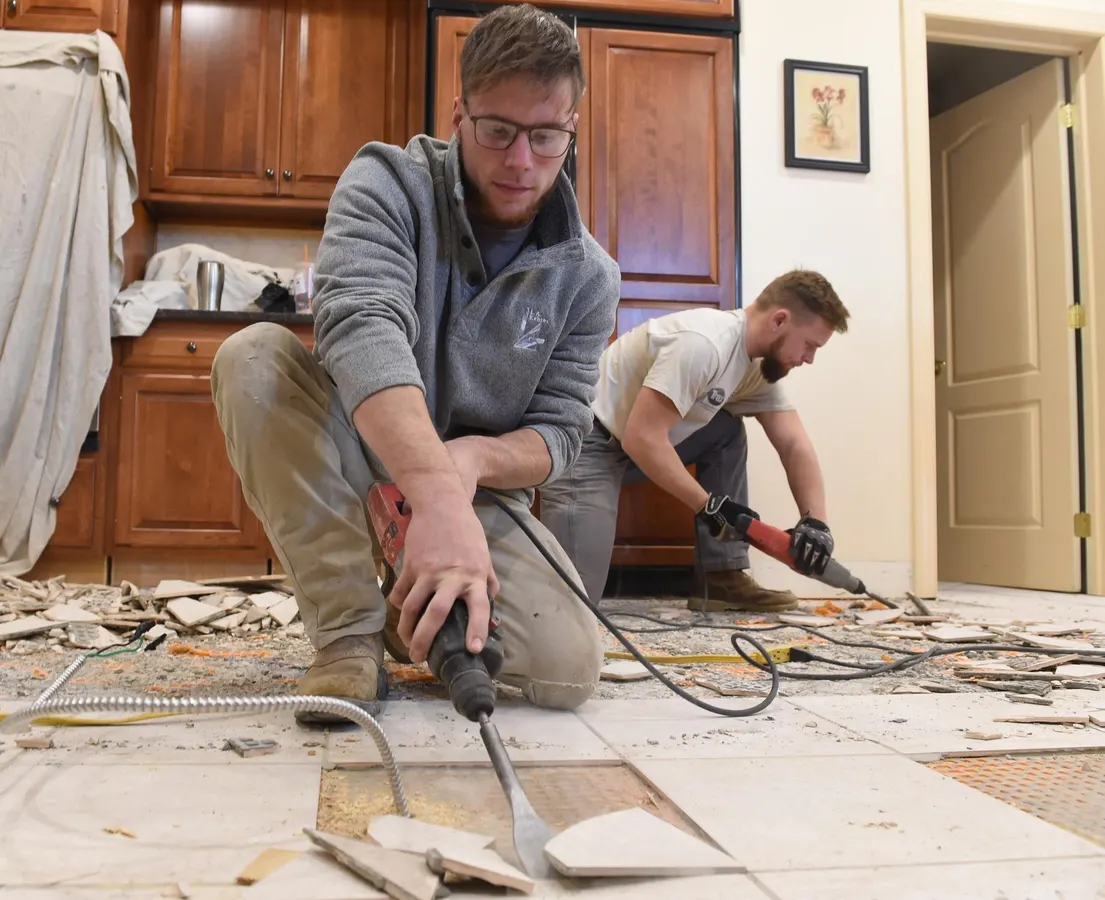Copyright forbes

Carpenters from L.A. Kehres Buidling and Remodeling work on a kitchen remodel. MediaNews Group via Getty Images In the middle of my own home improvement project, I have the fortune of an open canvas, but I constantly weigh the return on investment and I continue to manage the budget carefully. Data is critical in an individual project like this, and it is equally important at a macro level for the home improvement market. While important, it’s difficult to track this complex industry. Home improvement includes thousands of products and service providers that are siloed into individual aspects like specialty trades--from plumbing to roofing, from electricians to trim carpenters. Then, there are manufacturer sites and locations, design centers, big-box retailers, and ecommerce options for product selection. The Home Improvement Research Institute (HIRI) hosts an annual summit to provide clarity to industry stakeholders. This year, they did just that, and the clarity is that uncertainty is strong. Setting the Scene Despite its many challenges, homeownership is still the American dream. While the fundamentals of homeownership are changing—when we become homeowners, how, and for how long—it is still deeply rooted in our cultural identity. To allow more people to become homeowners and to experience home improvement projects, we need more homes, and we need them at lower cost. Those homes also need to offer new and different features. “We believe in the dream itself more than its attainability,” said Matt Carmichael, editor of What the Future at market research firm Ipsos. MORE FOR YOU With a lack of affordable housing options, many members of Generation Z are moving back in with their parents, which is shifting their priorities and expectations. “Gen Z prioritizes freedom over homeownership as the American dream,” Carmichael said. “Homeownership is less important than freedom by three to one. Health and finances are at the top of their goals, and technology is the thing that they’re willing to spend money on.” When someone becomes a homeowner, they are in it for the longer term than in the past. Homeowners in the U.S. aren’t moving as much—37% live in the hometown they grew up in. With remote work options and high interest rates, there is less incentive now for people to move than ever. Carmichael also outlines two pivotal time periods that never existed in housing. There is now a life stage in a person’s 20s where they are single and have disposable income, a time that used to be filled with the adult progression of marriage and kids but that is now delayed for experiences. Plus, we are outliving our lifespan by nearly a decade, which adds another 10 years that also never existed. Todd Tomalak, principal at housing market research firm Zonda, agrees that medical advances are helping people live five years longer and leading to the need for an extra 800,000 homes, not to mention the upgrades to existing homes to make them appropriate for aging in place. With these factors and more in mind, forecasts for remodeling growth in 2026 range from 1.8% to 4%. Danushka Nanayakkara-Skillington, assistant vice president for forecasting and analysis at the National Association of Home Builders (NAHB), was at the high end, reporting that residential remodeling will end with a 10% increase this year, see a more modest 4% next year and rise up again in 2027 to a 6% increase. While fears of a recession are eroding, Skillington estimates a 30% chance, and Michael Zdinak, president at S&P Global, forecasts continued expansion with no recession in 2026. The Home Improvement Climate Change Storm With more than 80% of home buyers now considering climate risk when buying a home, there are bound to be big impacts on the marketplace. “Climate risk is deeply embedded in housing economics,” said Kara Ng, an economist at Zillow. “Climate risk is reshaping affordability and consumer behavior. Climate risk is no longer just an environmental issue; it is a housing market influence.” Home improvement professionals have an opportunity to get ahead of consumer demand to harden homes and defend against the next climate event because homeowners are proactively investing to manage climate risk, spending an average of $952 per year in climate-related upkeep and $10,000 in one-time resilience projects such as waterproofing, drought-tolerant landscaping and fire hardening. Zillow reports that $17 trillion in property is at major wind risk, $9 trillion at major fire risk and $7 trillion at major flood risk. Thumbtack’s recent “The Home of the Future” report says durability is emerging as the next frontier. The most important features cited for the home of the future were disaster-resistant materials (90%) and predictive maintenance tools (88%)—systems that send alerts before issues occur. With more climate risks, Thumbtack also sees homeowners considering durability not as a nice-to-have but as a necessity. The presenters at the HIRI Summit loved talking about uncertainty. It was a theme stretching from the impacts of tariffs to the government shutdown, to immigration policy and labor shortages--all creating headwinds for home improvement. Zdinak forecasts that even though tariffs have been slow to pass through, they will, but fortunately, the impact may not be as strong as expected. The Farnsworth Group reports that 73% of pros have seen increases in material and project costs. The firms president, Grant Farnsworth, says these cost increases are the biggest challenge for pros at the moment, even beating out labor shortages. With costs as a concern, contractors are shopping around and using ecommerce more than ever to find the right product at the right price. Tomalak has seen ecommerce spend go from 4% to 10% of purchases from pre-COVID levels. While maybe a shifting challenge, labor certainly cannot be ignored. As part of the increased project costs, construction pay has gone up by 4 to 5%, said Ken Simonson, chief economist at The Associated General Contractors of America. “Firms are hanging on to workers because it’s difficult to train new ones,” he said. “Plus, harsh immigration actions worsen labor shortages. Construction trades rely heavily on immigrants—34% of workers were foreign born, nearly double the rate of foreign born for other industries. Twenty-eight percent of firms were affected by immigration enforcement actions. Five percent reported being visited by immigration agents.” In the past six months, firms have canceled or delayed projects due to increasing costs (43%), financing issues (31%), policy changes (26%) and tariffs (16%). AI In Home Improvement There isn’t an industry that isn’t impacted by artificial intelligence right now. And while some industries are a bit slower on the uptake, contractors and consumers are benefiting from AI-powered tools that open a new realm of possibilities. “Technology is for the first time ever adapting to us,” said Michael Anschel, principal at OA Design+Build. “That’s the playing field of this year. It is trying to figure out what we want, modifying itself to fit our way of doing things.” Thumbtack’s “The Home of the Future” report also uncovered that homeowners see AI as a transformative force for the home. Nearly 80% of homeowners believe AI has the potential to improve their homes, and 46% say it will make homes better, smarter and easier to care for.” That extends to the bottom line. Homeowners think AI and future-ready technology will boost a home’s resale value by 15% in the next ten years. But, AI has to build trust and proof first. Nearly 80% of homeowners rate privacy protections as a non-negotiable before adopting AI, in addition to guarantees of product reliability over time (76%). Younger homeowners are more demanding--34% of Gen Z want legally assured privacy protections before bringing AI into their homes. While homeowners have unique concerns, remodeling pros are small business owners and Anschel points out that AI will empower them to be more competitive on a larger landscape—if they can learn to adopt it effectively. AI will help them look for anomalies, approve, pay and update books. Construction project management platform Buildxact offers an AI Estimate Reviewer that checks what may have been missed when an estimate was prepared. It gives smart tips on compliance, missing materials, labor costs and other oversights that might lead to lost profit. AI will soon be able to take on marketing, an area that so many contractors aren’t strong in. Agentic tools launched recently that can negotiate advertising, placement, analyze performance, handle payment, and rates, and terminate contracts if the performance is bad. “AI will do a better job understanding projects than you will,” Anschel said. “It won’t fully replace your team, but it will take jobs.” Yet, the role of relationships may have the opportunity to grow in importance in the world of AI. “The human component is critical when there is friction,” said Farnsworth. “You have to meet professionals where they are, when they need you.” The Silver Linings Contractors are seeing a lot of positive momentum and even banking on a better year next year. Bidding and project activity picked up in the third quarter and contractors won 73 percent of bids, Farnsworth reported. Zdinak points to other tailwinds, in particular one that will surprise consumers. “The tax cuts from One Big Beautiful Bill will spur spending,” he said. “People don’t realize they are coming and will get a bigger refund than expected.” Dave King, executive director at the HIRI, forecasts a stronger consumer home improvement spend in the next years, driven by disposable income more than consumer sentiment. “Across generations, remodel spend is driven by income—the top 20% of income earners account for roughly 50% of spend in home improvement,” he said. “In the third quarter, consumers planned to spend more on home improvement during the next 12 months with pragmatic drivers being the most important—cost is driving consumer decisions.” Tomalak also sees some uptick in home improvement activity as homeowners take on postponed projects. He envisions the delayed spending like holding a beach ball under water, and thinks it is about to pop up. While the tax refund could help, Skillington reports that the consumer personal saving rate has dropped to about 5% from 7% before COVID. “People are saving less because expenses are up,” she said. “Credit cards are at $1.3 trillion. Auto loans are at $1.6 trillion. The value of loans is higher with depreciating assets.” Whether they are saving or not, the tax refund could help fuel the interest in futuristic home remodels. Thumbtack reports that nearly one in three Gen Z homeowners want immersive VR or AR living spaces in their homes. A majority want flexible designs--77% of Gen Z like the idea of adaptive interiors—smart walls, floors or partitions that can shift with light, temperature or use. Younger generations also consider sustainability in futuristic terms, with 32% of Gen Z pointing to biodegradable materials as one of the most promising innovations for tomorrow’s homes. Plus, 24% are intrigued by smart windows that automatically tint to reduce glare and heat. These futuristic ideas have helped me reimagine my improvement project, and I’m excited to see what the industry has in store. Editorial StandardsReprints & Permissions



